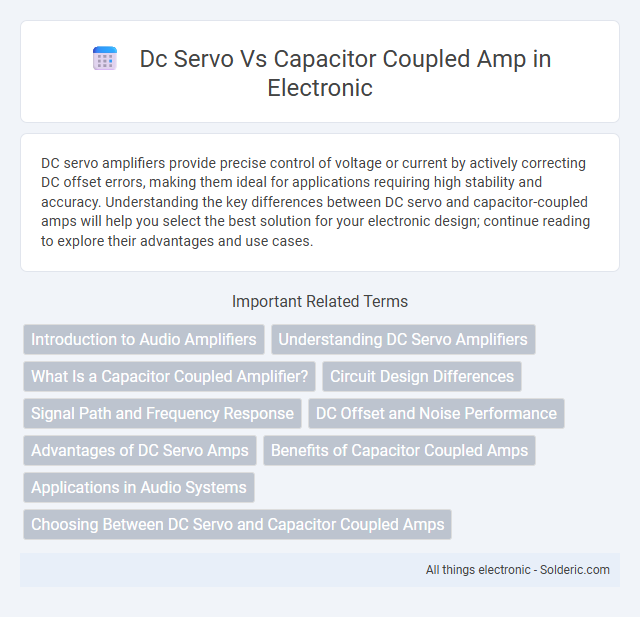DC servo amplifiers provide precise control of voltage or current by actively correcting DC offset errors, making them ideal for applications requiring high stability and accuracy. Understanding the key differences between DC servo and capacitor-coupled amps will help you select the best solution for your electronic design; continue reading to explore their advantages and use cases.
Comparison Table
| Feature | DC Servo Amplifier | Capacitor Coupled Amplifier |
|---|---|---|
| Operation Principle | Uses DC feedback loop to eliminate offset voltage | Uses capacitive coupling to block DC components |
| DC Offset | Minimized by servo mechanism | Present but blocked at output |
| Frequency Response | Wide bandwidth, stable DC gain | Limited low-frequency response due to coupling capacitor |
| Signal Integrity | Better for low-frequency and DC signals | May introduce phase shift and distortion at low frequencies |
| Complexity | More complex circuitry with feedback loop | Simpler design, fewer components |
| Applications | Precision DC amplification, instrumentation | Audio amplifiers, AC signal processing |
Introduction to Audio Amplifiers
Audio amplifiers are essential for enhancing sound signals, with DC servo and capacitor coupled amps being two common types. DC servo amplifiers use feedback mechanisms to eliminate DC offset, ensuring minimal distortion and preserving audio fidelity. Capacitor coupled amplifiers block DC components with capacitors, providing a simple design but sometimes introducing low-frequency roll-off and phase shift issues.
Understanding DC Servo Amplifiers
DC servo amplifiers maintain a stable output by continuously correcting DC offset errors, a critical function for precision applications such as audio equipment and instrumentation. Unlike capacitor-coupled amplifiers that rely on capacitors to block DC components but introduce phase shifts and potential low-frequency signal distortion, DC servo amplifiers use feedback loops to minimize offset voltage without degrading signal integrity. This results in improved accuracy, reduced distortion, and enhanced low-frequency response in systems requiring precise DC balance.
What Is a Capacitor Coupled Amplifier?
A capacitor coupled amplifier uses capacitors to connect different stages, blocking DC voltage while allowing AC signals to pass, which prevents DC bias shifts between stages. This design minimizes DC offset errors but may introduce frequency response limitations at low frequencies due to capacitor reactance. In contrast, DC servo amplifiers actively stabilize the DC operating point, providing superior low-frequency response and reduced offset drift.
Circuit Design Differences
DC servo amplifiers use feedback loops with DC error correction to maintain zero offset voltage, while capacitor coupled amplifiers rely on capacitors to block DC components and pass only AC signals. The DC servo design incorporates integrators and error amplifiers to stabilize the output, eliminating drift without external coupling capacitors that can introduce distortion. Your choice depends on circuit performance needs, with DC servo amps providing higher precision and lower drift compared to capacitor coupled designs.
Signal Path and Frequency Response
DC servo amplifiers employ feedback loops to maintain zero DC offset in the signal path, resulting in minimal distortion and stable operation across low frequencies. Capacitor-coupled amplifiers use capacitors to block DC components, which introduces phase shifts and limits frequency response at the lower end due to high-pass filtering effects. Your choice between these designs impacts audio fidelity and signal integrity, particularly in applications requiring accurate low-frequency reproduction.
DC Offset and Noise Performance
DC servo amplifiers effectively minimize DC offset by continuously monitoring and correcting output drift, ensuring stable signal integrity in precision applications. Capacitor-coupled amplifiers exhibit inherent DC offset due to input bias currents and capacitor leakage, which can introduce significant low-frequency noise and signal distortion. Noise performance in DC servo amplifiers is generally superior as the active feedback loop reduces flicker noise and drift, while capacitor-coupled designs may suffer from increased noise floor and reduced signal fidelity over time.
Advantages of DC Servo Amps
DC servo amplifiers offer superior low-frequency stability by continuously correcting offset voltages, which prevents output drift and distortion. Their ability to maintain a zero-crossing output without external adjustment enhances signal accuracy in precision applications. By minimizing capacitor-related phase shifts found in capacitor-coupled amps, DC servo amps ensure cleaner, more reliable performance for your sensitive electronic circuits.
Benefits of Capacitor Coupled Amps
Capacitor coupled amplifiers offer improved signal stability by blocking DC offset and minimizing drift, enhancing overall audio quality in sensitive applications. Their high-frequency response is superior due to reduced low-frequency phase shift, which is critical in precision instrumentation and communication systems. These amplifiers also simplify circuit design by eliminating the need for complex DC feedback networks, reducing power consumption and increasing reliability.
Applications in Audio Systems
DC servo amplifiers provide precise low-frequency control and minimize offset voltage, making them ideal for high-fidelity audio systems requiring accurate signal reproduction and minimal distortion. Capacitor-coupled amplifiers excel in simpler audio applications by blocking DC components and allowing AC signals to pass, but they may introduce phase shifts and limited low-frequency response. Your choice between these amplifiers depends on the audio system's need for precision and overall sound quality versus cost and design simplicity.
Choosing Between DC Servo and Capacitor Coupled Amps
Choosing between DC servo and capacitor coupled amplifiers depends on your application's precision and signal integrity requirements. DC servo amps continuously correct offset voltages, minimizing drift and enabling accurate low-frequency or DC signal amplification, while capacitor coupled amps block DC offsets but may introduce phase shift and limit low-frequency response. Selecting the right amplifier hinges on whether your system prioritizes offset stability and low-frequency fidelity or simplified design and isolation from DC components.
dc servo vs capacitor coupled amp Infographic

 solderic.com
solderic.com